

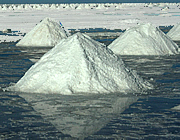
The spectacular landscapes of Bolivia drew us to travel throughout the country to vast salt flats, numberless volcanoes and multi-coloured lakes. Unforgettably spectacular.
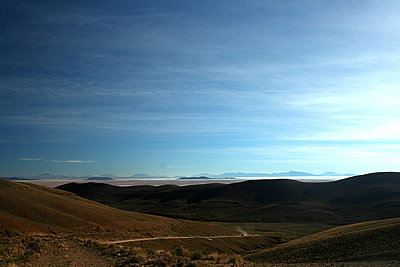
Over four hours drive from Potosi we had our first glimpse of the Uyuni Salt Flats in the far distance - one of the main reasons for venturing this far into Bolivia.
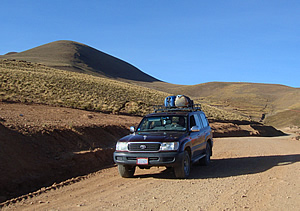
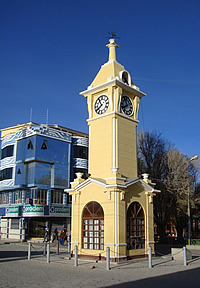
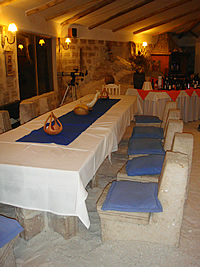
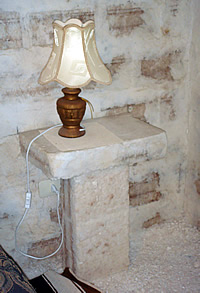
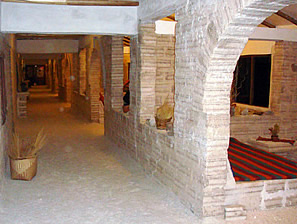
The drive had been quite arduous, with much of it on dirt roads, so we were glad to reach the town, though it isn't particularly attractive. While our driver filled up the car we stretched our legs, investigating an illegal car lot, where cars without number plates were openly sold, and the train station which has some old rolling stock. Then on to the Salt Hotel. The view from the hotel is magnificent: from the middle distance vast expanses of salt flats stretch as far as the eye can see.
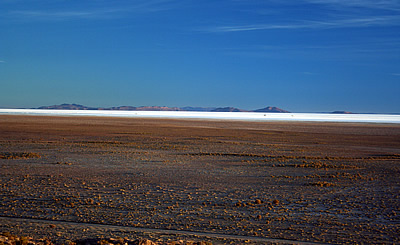
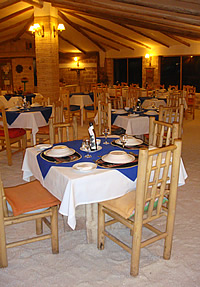
The Salt Hotel itself, though, is definitely an experience, but not one I'd wish to repeat. Completely made of salt it is quite remarkable: salt benches, night tables, walls and crunchy salt floors. It was freezing - really freezing! The long corridor from reception is lined with alcoves with fireplaces and huge windows from which to look at the salt flats, but far too cold to sit in and none of the fires were lit. At dinner I chose a table right next to one of the heaters and huddled close to it all the time we ate.
Thankfully the bedrooms have heaters, and lots of duvets - we slept under three and I was practically fully clothed with thermals and socks and even a woolly hat for the first part of the night as well! The bathrooms are better, with hot showers and no crunchy salt floor.

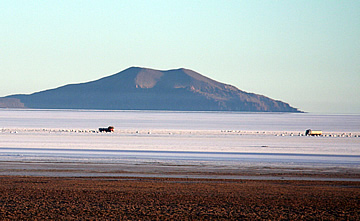
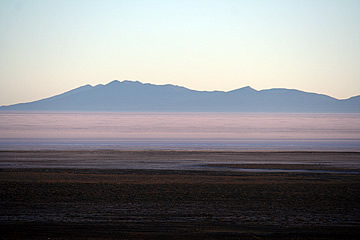
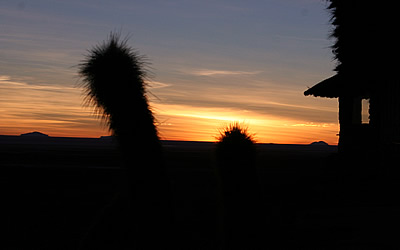
Before dinner we bundled ourselves into warm jackets and went out to watch the sunset over the salt flats. The vast expanse of salt turned pink as the sun sank and the sky deepened to an orange glow. An amazing sight which augured well for the days to come.

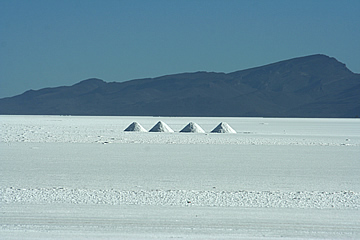
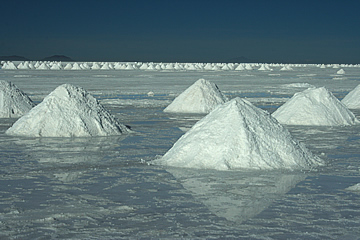
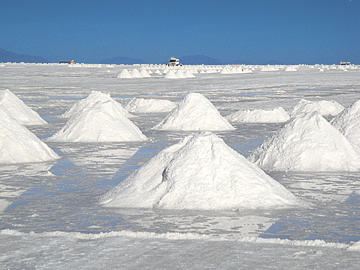
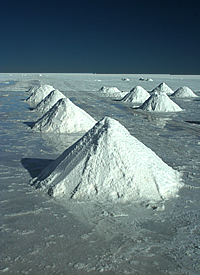
The next morning we drove out onto the fantastical landscape of the salt flats, the largest in the world at over 10,000 sq km of salt, fringed with mountains and volcanoes. We saw men working the salt into conical piles for drying before taking it away.
There had been rain and in some areas there was quite a bit of shallow standing water.
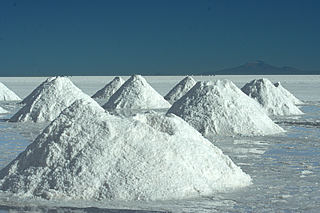
It is absolutely dazzling out on the salt flats and sunglasses are essential.
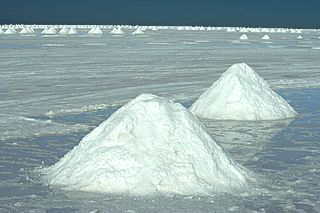

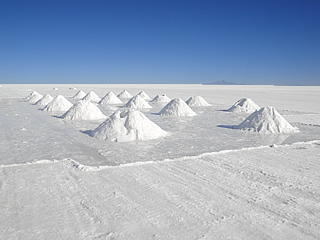
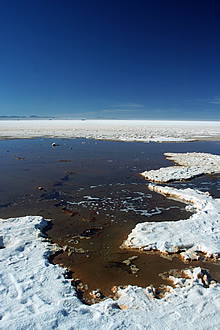
There are warm bubbling saline springs in the area where we entered the salt flats, called the Eyes of the Salt Flats, but thereafter just salt as far as the eye can see and Fish Island marooned in the salt.
We were taken to a salt museum marooned on the salt flats. It had an obligatory entrance fee for which you can also choose a small gift and a small selection of unimpressive salt sculptures. We didn't want to visit this but it almost seemed compulsory!
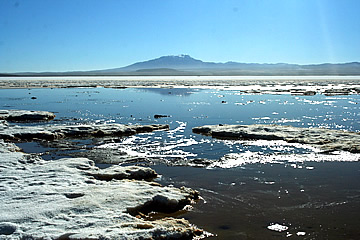
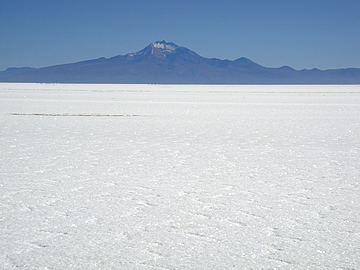
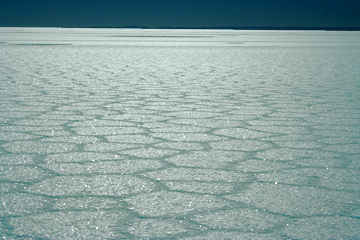
As we got further into the centre of the salt flats it was much drier and the surface took on a cellular structure, though not as regular as I would have expected.
It is amazingly quiet, literally nothing to be heard.
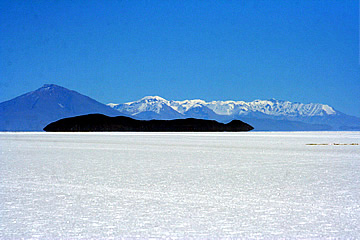

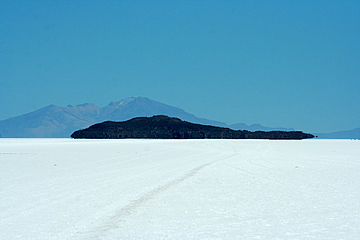
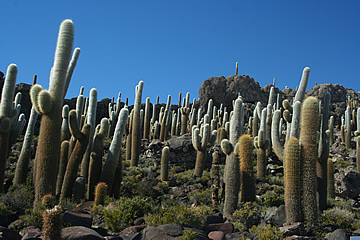
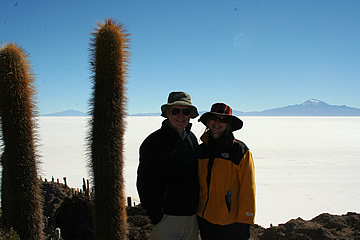
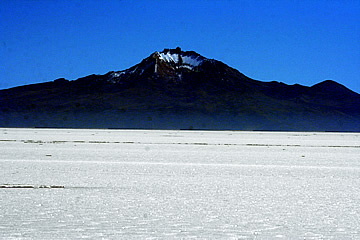
Apparently Fish Island gets its name from the illusion created when there is a lot of standing water on the salt flats and the reflection of the island makes it look like a fish.
We spent some time on Fish Island, walking right to the top then back down the other side and having lunch at the small restaurant there - not the greatest lunch we've ever had!
The views from the top are just amazing: salt as far as the eye can see to the horizon in every direction.
The island is covered in huge cacti, the whole effect is truly surreal. One of the most amazing places we've ever been.
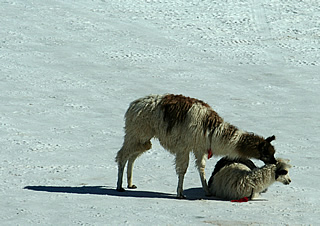
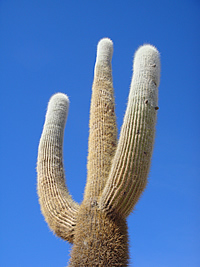
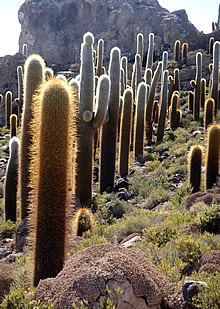
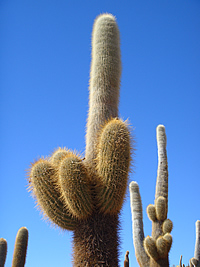
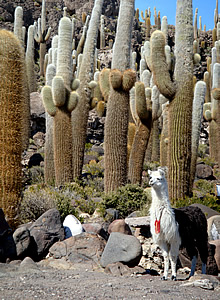
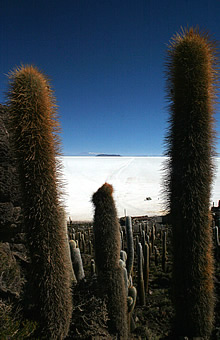
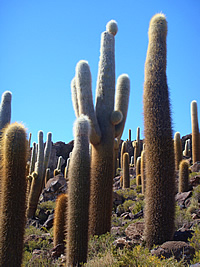
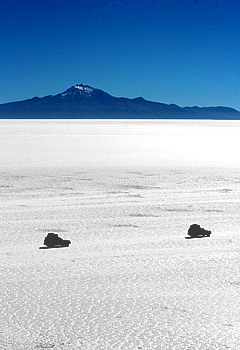
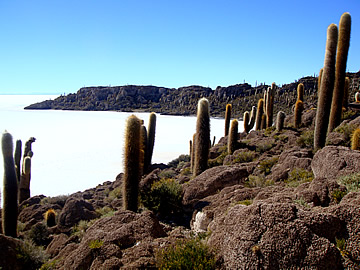
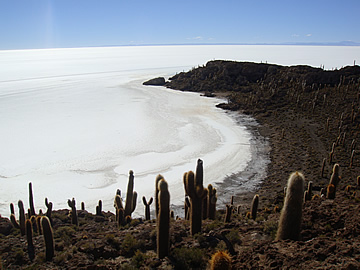
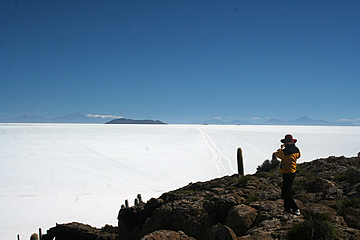
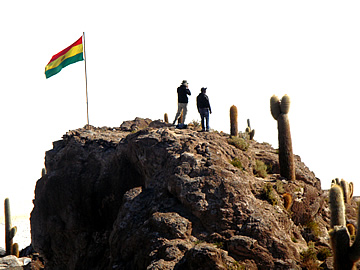

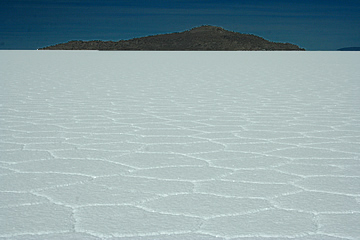
After lunch we ventured north on the salt towards Coquesa but soon we could see expanses of water which barred the way. We started south heading across the salt flats for our next destination, San Pedro de Quemez. Our guide and driver had wanted to do this with another vehicle for company but they didn't turn up so we went on our own.
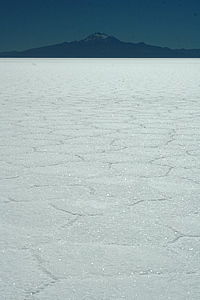
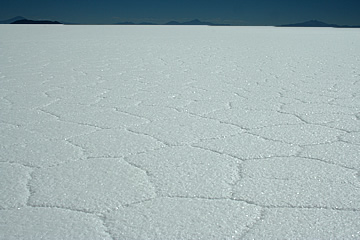
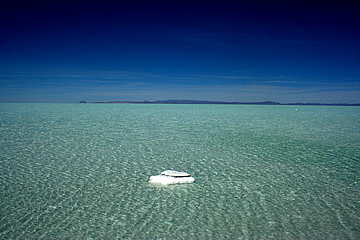
It soon became apparent why they'd wanted a bit of back-up available - the water began to appear in pools but soon in a continuous shallow lake that we were driving through. There were very few landmarks to navigate by and the guide and driver were looking for cairns of stones which mark the way off the salt flats.
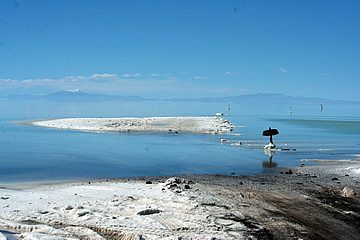
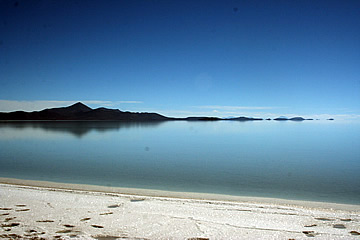
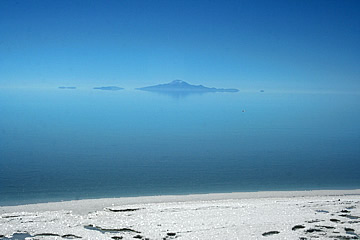
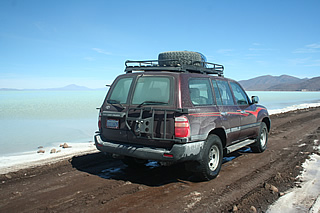
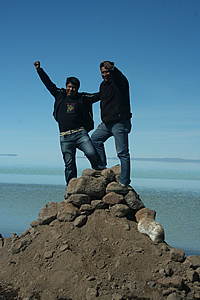
We drove for quite some time just heading in the right general direction, our binoculars came in very useful, eventually showing a cairn in the distance.
It was quite nerve-racking for a while and we were grateful we had such a good driver.
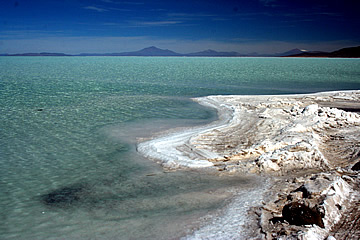
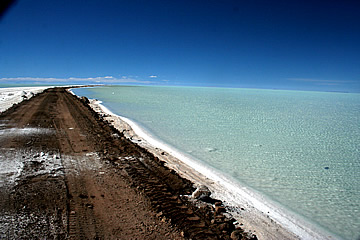
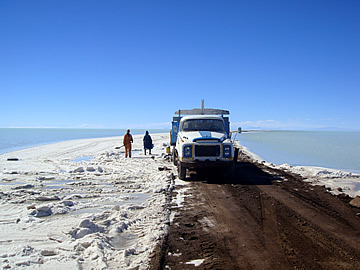
On this side we met a husband and wife who were collecting salt to build a hostel in the nearby settlement. A tough life.
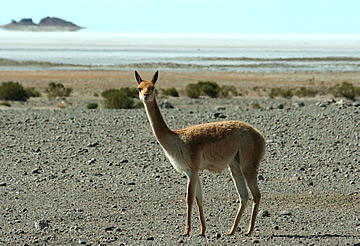
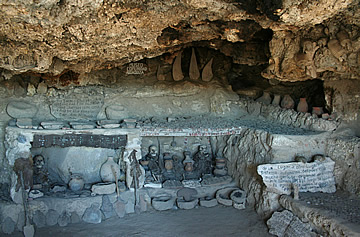
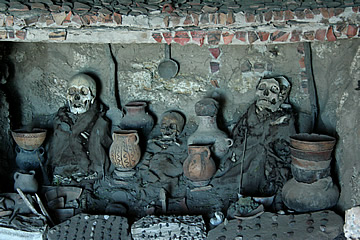
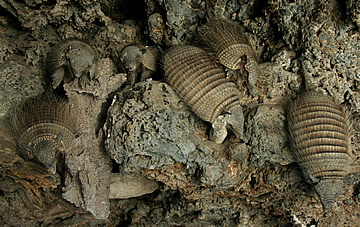
We skirted the salt flats for a while, spotting beautiful vicuña on the way, before heading inland on the dirt track which was to be our lot for the next few hundreds of miles.
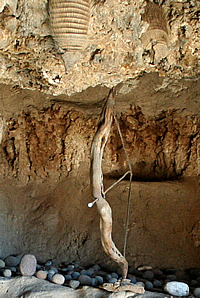
As we'd been unable to see the mummies at Colquesa our guide took us to two ancient grave sites on our route.
The first was actually set up as a small museum inside a burial cave. Alongside 10,000 year old mummies with their grave goods were a wealth of artefacts. This was, by many thousands of years, a pre-Inca Aymara community. Apparently they used the caves as homes as well as burial places. One of the groups looked to be two adults and a child. All the mummies, little more than skeletons, were upright in a kind of squatting position and looked to be wrapped in dark cloth. The edges of the rectangular cavities in which the bodies were placed were decorated with broken pieces of painted pottery.
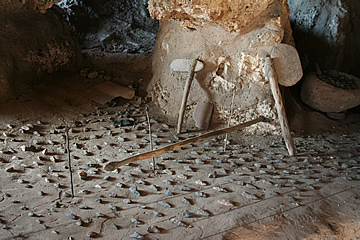
Among the artefacts were pots, some with primitive decorations, bows and arrows, axes, many flints, small round stones and a number of mummified armadillos attached to the ceiling of the cave. What significance any of this had we don't know - perhaps some of it was just created to enhance the look of the museum.
There was no-one in attendance - it was in the middle of nowhere - so we left a donation.
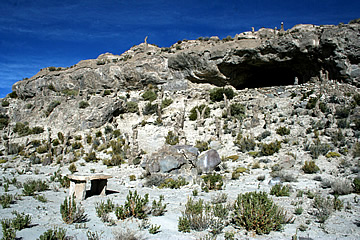
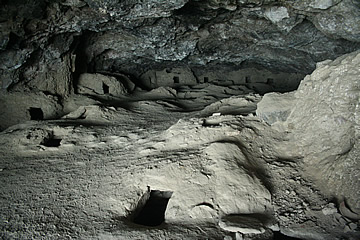
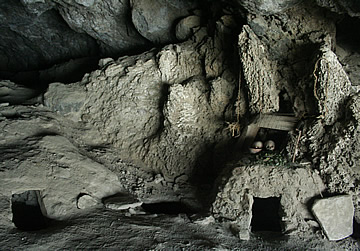
On to the Galaxy Cave which apparently has stalagmites and stalactites. However, as it was Sunday, it was closed and there was no-one in attendance. Of far greater interest to us was a nearby cave burial site of the same age as that at Aguaquiza.
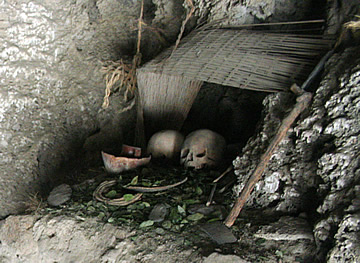
This, however, was in its natural state, within a huge cave set in a hillside above the plain. The burials were made in walled-in enclosures or cavities in the floor. It's a very eerie and atmospheric place with a fantastic view from the cave mouth.
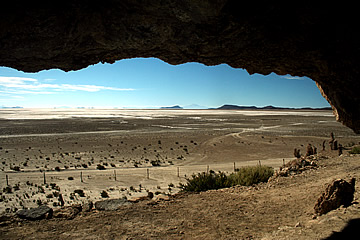
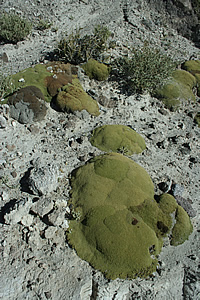
The land here is very poor, with an awful lot of salt. Yet some extremely hardy plants manage to survive. These seemed to be either low, very thorny bushes, or yaretilla which looks like a lichen but is actually composed of thousands of tiny plants. This is a favourite food of the vicuñas and we saw a number of them grazing here.
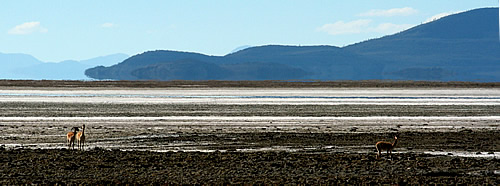

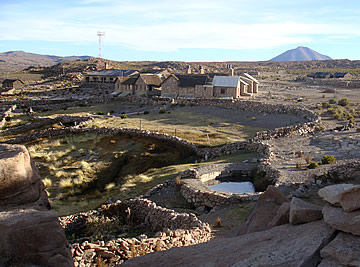
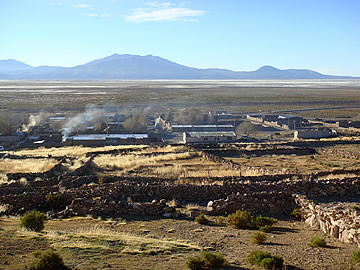
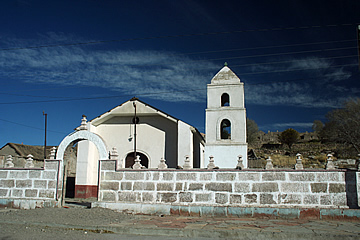
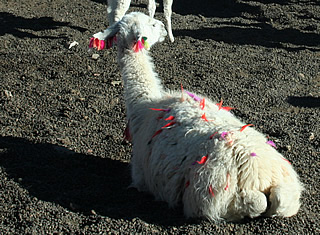
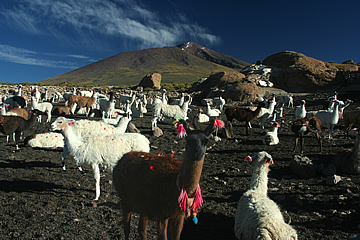
San Pedro de Quemez is known as the Burnt Village because the original village was burned down by the Chilean army during the War of the Pacific1879-1883 when Chile was fighting Bolivia and Peru over mineral resources. There isn't really much to see, just standing stone walls of the various buildings. The surrounding landscape is quite desolate: a huge flat plain ringed with mountains and volcanoes.
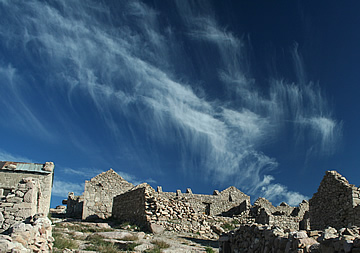
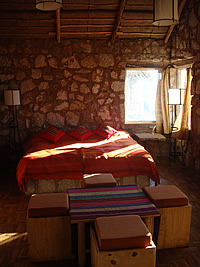 Even the bed base is made of stone.
Even the bed base is made of stone.
We were staying at the Tayka Hotel Pedra which, for the area, is more than adequate. We had a huge room with a surprisingly good, hot shower - the water is solar heated and only hot until about 6:30pm.
It became extremely cold in the evening, though the room was heated you really had to be right next to the heaters to feel any warmth. Plenty of blankets to keep out the cold overnight, though, and the very friendly owner had placed pedestal heaters in the dining room so we could be warm over dinner.
By this stage we were getting a little tired of the evening meals which seem always to be of the same format: usually an excellent home made soup but then meat of some description invariably served with cold vegetables. Here, true to form, the soup was very good with the added bonus of home made bread rolls.
Overnight I woke and lay looking out of the wndow next to the bed. I couls see millions of stars in the night sky and two shooting stars.
Breakfast was good, including home made rolls and fried eggs setting us up nicely for a walk down through the village via the llama enclosures to meet our driver.
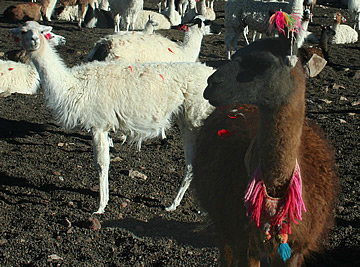
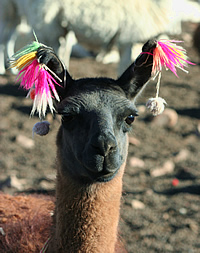
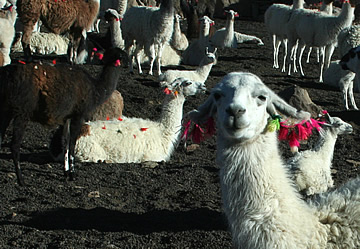
They are funny creatures, very curious about us, and with comical facial expressions.
Many were "decorated" with lengths of coloured wool and pompoms - I think some kind of identification device.
